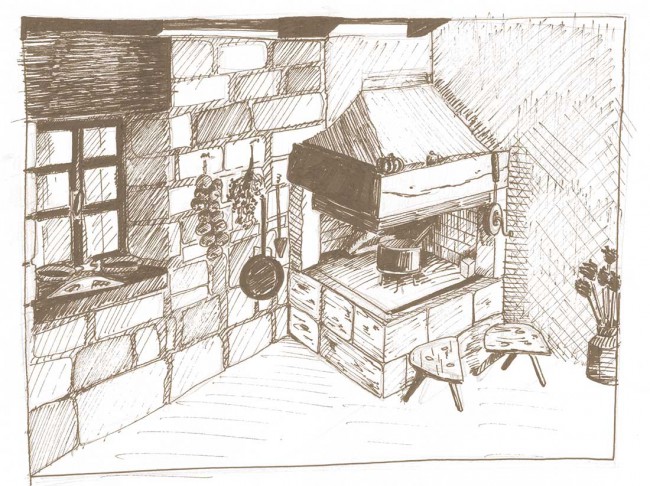Komin or the Fireplace
Komin held a special place in the life and history of a Dalmatian family. It was the central part of a Dalmatian house where women cooked and the main gathering place for the whole family, especially in the winter, when all the other rooms were too cold. Cooking always meant fire making, which enabled the heating of this room, another reason why komin had a crucial role in the life of our ancestors.
In the bottom of this room there was a fireplace made of brick clay, slightly lifted off the ground and detached from the wall, which served for the preparation of the food. A table, chairs and three-legged stools were located in the middle of the room, while only the rich families had a fitted cupboard to keep the plates, pots, cups, glasses, flasks etc. There were two windows to release the smoke. Chopped wood was kept in the corner, while there was often a bed next to the fireplace, for elder people or for pregnant women. Besides having a central part in the life of a Dalmatian family, komin was also a room which brought money to the house since sage, a once greatly appreciated aromatic herb, was dried here.
Peka or Baking lidKomin served for the preparation of traditional dishes of the Dalmatian hinterlands, Zagora. Peka holds a special place in the traditional gastronomy of this region. In fact, peka is closely related to the Dalmatian Zagora, given that the inhabitants of this region, going back from the ancient Illyrians onwards, had never accepted the Roman bread oven. Our ancestors made it from clay or iron; however, we cannot be sure whether the first one was made by a potter or a blacksmith. In the beginning, peka consisted only of clay or forged cover, while the food was beaked on the fireplace. Only later has it evolved to what we call peka today – a shallow dish which is covered by clay or forged lid and the essential hoop which helps keep the embers on the lid. However, what has not changed at all is the technique of baking. First, it is important to make a good wood fire and let it turn into embers. Then, we put the food into the shallow dish and cover it with a lid. The embers are put on the lid, but not excessively. The embers should glow for an hour and half, just about enough time to make most of dishes traditionally made using peka.


